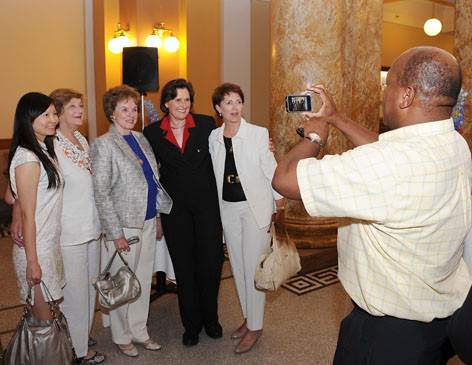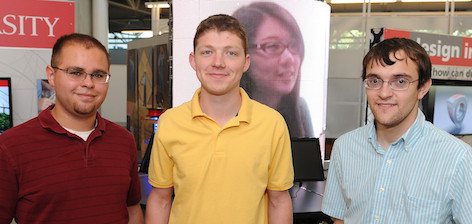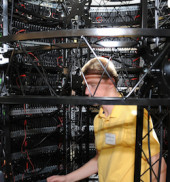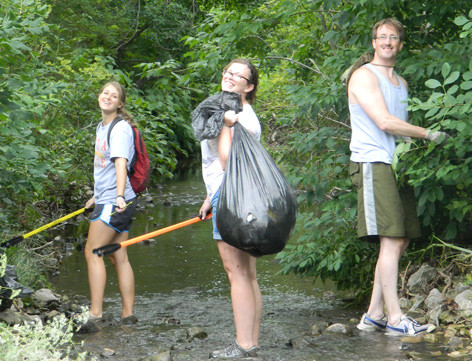A job well done

Well-wishers gathered in Beardshear Hall last week to thank Elizabeth Hoffman for her many contributions as Iowa State's executive vice president and provost. She has held the post since Jan. 1, 2007, and will step down on July 30. Hoffman, who also served as dean of the College of Liberal Arts and Sciences from 1993-97, is a professor of history and of economics. Photo by Bob Elbert.
Students key to Iowa State's Smithsonian Folklife Festival exhibit

Christopher Waters, Chris Van Oort and Michael Ore helped make the exhibit's software and hardware work. Photo by Bob Elbert.
Seven Iowa State students played essential roles in the creation of Iowa State's exhibit for the 2012 Smithsonian Folklife Festival, June 27-July 1 and July 4-8, in Washington, D.C.
The students helped refine the exhibit concept, build the model, research the hardware, program the games, design the custom control system, write the software, build the web browser and much more.
"They made it actually work," said Arthur Croyle, associate professor of integrated studio arts and one of the exhibit designers. "We really couldn't have done it without them. We had the idea and concept, but they actually made it work."
The students are Amy Edmondson, senior, industrial design; Chris Van Oort, senior, software engineering; Kyle Brumm, junior, software engineering; Michael Ore, senior, computer engineering; Christopher Waters, senior, software engineering; Qian Zhang, sophomore, computer science; and Adam Carver, senior, advertising.
Student designer

Edmondson
The "Transforming Communities: Design in Action" exhibit blends advanced interactive technology and old-fashioned conversation to demonstrate the techniques and processes designers use to help communities solve complex problems. Created by a team from the College of Design and ISU Extension and Outreach, the exhibit highlights the role of design in the land-grant mission. Iowa State was one of 17 land-grant universities selected to participate in the festival's celebration of the 150th anniversary of the founding of land-grants.
Edmondson, who has an interest in exhibit design, heard about the Smithsonian exhibit in January. She asked to do an independent study with David Ringholz, chair of industrial design and lead exhibit designer. As a member of the exhibit design team, she's been "at the table" ever since, contributing in countless ways and soaking up the experience.
"I've participated in the exhibit design almost from its infancy," Edmondson said. "Part of the joy of designing in a group is the wonderful discussions that occur when designers work together to shape a project that creates an effective experience for the exhibit user."
Edmondson oversaw a student design competition, built the scale model of the exhibit and interviewed faculty for a video that is part of the exhibit. And she served as liaison between the design team and the student programmers to assist in creating the touchscreen games.
"I've learned a great deal about communication, organization and the importance of building a good team," she said.
Edmondson will staff the exhibit throughout the festival along with university faculty and Extension and Outreach staff.
Student engineer

Van Oort in the exhibit's control central. Photo by Bob Elbert.
Van Oort also will staff the Iowa State exhibit on the National Mall. He will manage the exhibit's extensive hardware and software, which he helped plan and develop. As the student technology lead on the exhibit, he advised the design and content teams on all aspects of technology — from software and hardware possibilities to dust, cooling and power conditioning issues to building a custom control system.
"Specifically, I've designed the communication and control system between four touchscreen kiosks, a server and laptop that controls the huge LED displays. I also wrote a custom, full-screen, secure Web Kit-based internet browser for the kiosks," Van Oort said.
The vast array of technology involved in the exhibit requires a customized system capable of driving and controlling the various elements. A network of computers controls the elements and allows them to function together. iPads send text content to the LED ribbon-crawl atop the central column, a laptop streams video to the LED video screen and MacMinis control content on touchscreen game kiosks and TV monitors. In addition, each type of display requires a separate video controller. Van Oort was tasked with making all of the elements work together by using and designing multiple software applications.
"It's going to be pretty neat to have a million people flow through the exhibit and interact with the software and hardware we spent months planning and developing," Van Oort said.
Van Oort enlisted a team of students from across campus to work on the project. Ore set up the web server that sends content to the displays and queues up messages for the marquee.
Student programmers

Brumm
Three students worked on the programming for the touchscreen games, developing them as web apps that will send content to the back-end control system for display on the LED screens. Waters worked on the touchscreen games using HTML, JavaScript and CSS. He also helped wire the exhibit and test the panels. Brumm wrote the entire HTML code for the layout and styling of the games, and helped with the JavaScript that was needed. And Zhang worked on the game and web programming.
"We've been tackling challenges since day one — choosing the right hardware to achieve the desired result from the exhibit, then understanding how to build a system that could interact with the LED displays and dynamically provide content," Van Oort said. "I'm not sure a lot of people around the world have ever pulled off what we're doing."
Student versatility
Carver has been an intern for the university's Center for Excellence in the Arts and Humanities since January. During the past three weeks, he worked on the exhibit full time, helping with the logistics, wiring, crate building and packing, and anything the exhibit team needed.
"I have very little experience with technology, so it's been great to learn so much about electrical power and LED technology," Carver said.
Carver will join the exhibit staff for the final days of the Folklife Festival and help with the exhibit tear down, packing and shipping.
Iowa State power plant knocked out in June 19 outage
The culprit for a dark campus last Tuesday afternoon was a rotted tree north of the Applied Sciences Complex -- and unfortunately along a major electrical line owned by the city of Ames. The tree's topple shortly before 3 p.m. shut down electrical power on two transmission lines to Ames, impacting not only the city and the Iowa State campus, but their power plants as well.
"It all happened in seconds, so there was no way to prepare for it," said ISU utilities director Jeff Witt. "The [power plant] equipment shuts down automatically when systems fail to prevent damage or injury.
"The longer we're down, the harder it is to come back," he added.
With the regional transmission system destabilized by the shutdown, about 30 minutes passed before Iowa State received the electrical power needed to restart its power plant. The first task was to make and pump clean water back into the boilers, and at 8:30 p.m., the first generator was turned on. By 9:30 p.m., it was generating power, and by 10:30 p.m., all campus buildings had electricity.
"[Restarting the plant] is a very methodical process," Witt explained. "Our staff knows what they have to do, but we have to be safe about it and we have to be careful not to damage the equipment."
Generating, purchasing electricity
However, Witt said that immediately following the outage, Iowa State also was communicating with city and MidAmerican officials to try to purchase available electricity. The university received approval from MidAmerican a few minutes after 5 p.m. to use more power than what was needed to restart the power plant. It was enough to restore power to about eight buildings on campus.
Iowa State typically purchases part of its electrical needs every day, so this was not unusual, Witt said. In fact, at the time of the outage, the university was buying about 40 percent of what it was using.
Prioritizing buildings for restored service considers a building's activities, especially research activities, and equipment, especially items such as freezers, Witt said.
"We make the best choices we can based on our knowledge of the buildings and the amount of power available," he said. "It's not a perfect process and most people understand that."
With the power plant's cogeneration capabilities, it was producing steam (for hot water and other building needs) by 10 p.m. Plant operators restarted the chilled water system (for air conditioning) around midnight, and by 4:30 a.m. Wednesday, Witt said, that system had returned to normal levels.
Elsewhere in Ames
The city owns two gas turbines for emergency situations and they were used to help make up the difference for city customers. Power was restored to most of Ames in less than an hour. At the time of the outage, the city was buying about 50 percent of its electrical power. Witt said the city's primary generator came back online at midnight.
Final analysis
University and city staff still are reconstructing what happened last week, with an eye on prevention in the future.
"This could happen again, so we want to be as prepared as we can be," Witt said. Shorter outages typically have shorter recovery periods, he noted.
The last time campus was without power for this long was in the 1970s, when a fire at the power plant shut down the plant and the campus grid.
Taking out the trash

Volunteers slosh along College Creek on a cleanup mission. Submitted photo.
Volunteers pulled 25 bags of trash from the banks and bottom of College Creek Saturday. In a preventative action, they also cleaned up nearby parking areas, hoping to keep lot litter out of the creek.
It was the fourth annual cleanup of the portion of the creek that winds through the southeast corner of central campus, and some 30 volunteers turned out to pick up 640 pounds of trash.
"That's an impressive haul when you consider that much of the trash is plastic bags, which weigh almost nothing," said Merry Rankin, director of sustainability. Rankin also noted that volunteers picked up a lot of parking receipts, likely from the pre-pay East Campus Parking Deck. She urges drivers to properly dispose of receipts, or better yet, forego them altogether unless they're needed for records.
One community
As in past years, the creek cleanup was as much a community event as a campus event, Rankin said.
"We had a lot of nice support from the Ames community," she said. "Individuals and families turned out to pick up trash. And area businesses supported the event with refreshments and door prizes for volunteers."
Student-driven
Rankin said a student intern in the sustainability office came up with the idea for a College Creek cleanup four years ago, and interns have planned and carried out the event since.
The cleanup is sponsored by the Live Green! program and Keep Iowa State Beautiful campaign, in partnership with facilities planning and management.
Stay cool
Heat tips
FAQ About Extreme Heat, Centers for Disease Control
While the heat wave may dampen your walk to and from the car, it shouldn't affect the temps inside your office this week. David Miller, associate vice president for facilities planning and management, said he doesn't anticipate any major concerns as the mercury rises in central Iowa.
At noon Wednesday, as the temperature inched above 90, Miller said the load on Iowa State's four large chillers was about 12,500 tons, well below last year's peak of 16,500. Miller said it takes a while for Mother Nature to heat the massive buildings on campus.
"We probably will not see our high loads for a couple of days."
Turn off the printer
While facilities staff manage the larger campus climate, Miller does have some advice for those of us sitting in the relative comfort of our offices.
"When the weather heats up, the more equipment you can shut down, the better," he said. "Equipment generates heat. By turning off that printer, you can make your office environment more comfortable and help the university save some energy."
